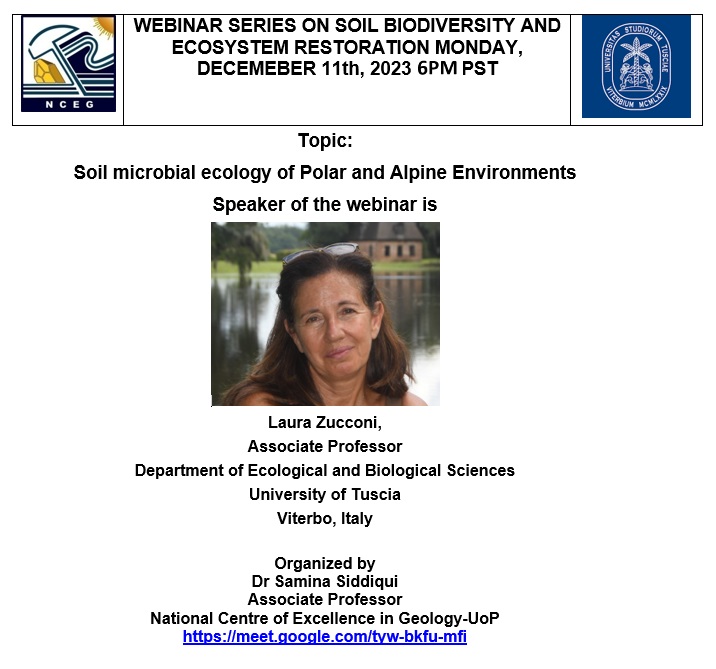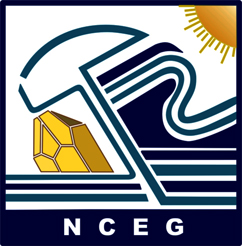
Webinar series Link: https://meet.google.com/tyw-bkfu-mfi
SUMMARY
Polar and alpine environments are among the most threatened by climate change, making them crucial hotspots for studying the effects of environmental shifts on soil ecosystems, which are the primary carbon sinks in cold environments. In this context, we conducted studies aimed at describing the relationships between the diversity and composition of soil microbial communities and the properties of their environments. We conducted various studies in the Alps to gain insight into how plant-associated soil ecosystems might respond to warming in terms of microbial diversity and metabolic activity. Using Open Top Chambers (OTC) and comparing microbial communities along an altitudinal gradient as a proxy for future shifts, we observed that warming has the potential to change the enzyme activity and that the migration of vegetation upwards may increase rates of microbial enzyme activity, increasing turnover of labile and readily accessible soil organic matter and promote the decomposition of recalcitrant biopolymers. These results were supported by metagenomic and metatranscriptomic approaches. A new experiment using a transplantation approach is currently ongoing at a different site in the Italian Alps. In this experiment, soil monoliths, containing native plants have been transplanted to a lower altitude (1000 meters shift) to simulate the effect of warming. Other monoliths have been used in a microcosm experiment at the CNRS-Ecotron of Montferrier-sur-Lez to simulate potential climate change scenarios.
However, in Antarctica, climate change is expected to lead to the disappearance of unique and highly adapted ecosystems. Also in this continent we conducted studies focused on understanding the relationship between the diversity and composition of soil fungal communities and the properties of their natural environments, aiming to monitor possible shifts related to environmental changes. Given the geographic isolation of the continent, we aimed to clarify the differential selection on microbial communities in the two substrata supporting life on the continent, namely rocks and soils. We found that the different microclimatic conditions of both substrata select highly differentiated fungal and bacterial communities, even if bacterial communities share a larger proportion of taxa between the two substrata. Additionally, due to the possible effect of extracellular DNA on the diversity estimations through DNA-based approaches, we performed a depletion of extracellular DNA through Propidium Mono-Azide (PMA). Comparing the results of PMA treated and native samples, we did not find significant differences in the total diversity and in the distribution of dominant taxa. However, extracellular DNA strongly inflated the analyses of correlations with environmental parameters, with a higher number of parameters and correlations resulting significant in extracellular DNA depleted samples.
Prof Dr Laura Zucconi (h-index 33) is Associate Professor in Botany from 2005. She has been involved in Antarctic Research projects from 1992 both as Principal Investigator or responsible of Research Units, as well as in projects in other extreme environments, as the Arctic (INTERACT-Horizon 2020) and Alps. She joined the 2014 Arctic expedition (Ny-Ålesund) and six Italian Antarctic Expeditions, also appointed by the Italian National Research Council (CNR) as Scientific Coordinator of the research activities carried out at the Italian Base during the XXVI, XXXV, and XXXVII Expeditions. Member of the Editorial Board of Section ‘Extreme Microbiology’ in Frontiers in Microbiology. Guest Associate Editor of two topics for Frontiers in Microbiology and two topics for Biology (MDPI). Her scientific activity focuses on microbial ecology, in particular on Antarctic soil and cryptoendolithic communities distribution, biodiversity and adaptation to different stresses. In the last years, her research is being extended in a deeper analysis of soil microbial communities through molecular approaches, to describe the effects of environmental conditions on their composition, functionality and adaptability. Her research activities range among different fields: systematic and taxonomy of filamentous fungi, ultrastructural morphology, molecular biology, astrobiology, adaptive responses to stress conditions – including real and simulated space conditions – of both single species and whole fungal communities. orcid.org/0000-0001-9793-2303 Researcher ID: U-9781-2018
Selected Readings:
- Canini F., Borruso L., Newsham K.K., D’Alò F., D’Acqui L.P., Zucconi L. (2023). Wide divergence of fungal communities inhabiting rocks and soils in a hyper-arid Antarctic desert. Environmental Microbiology, DOI: 10.1111/1462-2920.16534 .
- Sannino C., Cannone N., D'Alò F., Franzetti A., Gandolfi I., Pittino F., Turchetti B., Mezzasoma A., Zucconi L., Buzzini P., Guglielmin M., Onofri S. (2022). Fungal communities in European alpine soils are more resistant to short-term in-situ simulated warming than bacterial communities. Environmental microbiology https://doi.org/10.1111/1462-2920.16090
- D’Alò F., Baldrian P., Odriozola I., Morais D., Větrovský T., Zucconi L.*, Ripa C., Cannone N., Malfasi F., Onofri S. (2022). Composition and functioning of the soil microbiome in the highest altitudes of the Italian Alps and potential effects of climate change. FEMS Microbiology Ecology 98(3), fiac025.
- Canini F., Geml J., D’Acqui L.P., Buzzini P., Turchetti B., Onofri S., Ventura S., Zucconi L. (2021). Fungal diversity and functionality are driven by soil texture in Taylor Valley, Antarctica. Fungal Ecology 50, 101041.
- Canini F., Zucconi L.*., Coleine C., D’Alò F., Onofri S., Geml J. (2020). Expansion of shrubs could result in local soil bacterial diversity loss in Western Greenland. FEMS Microbiology Ecology fiaa089, https://doi.org/10.1093/femsec/fiaa089

